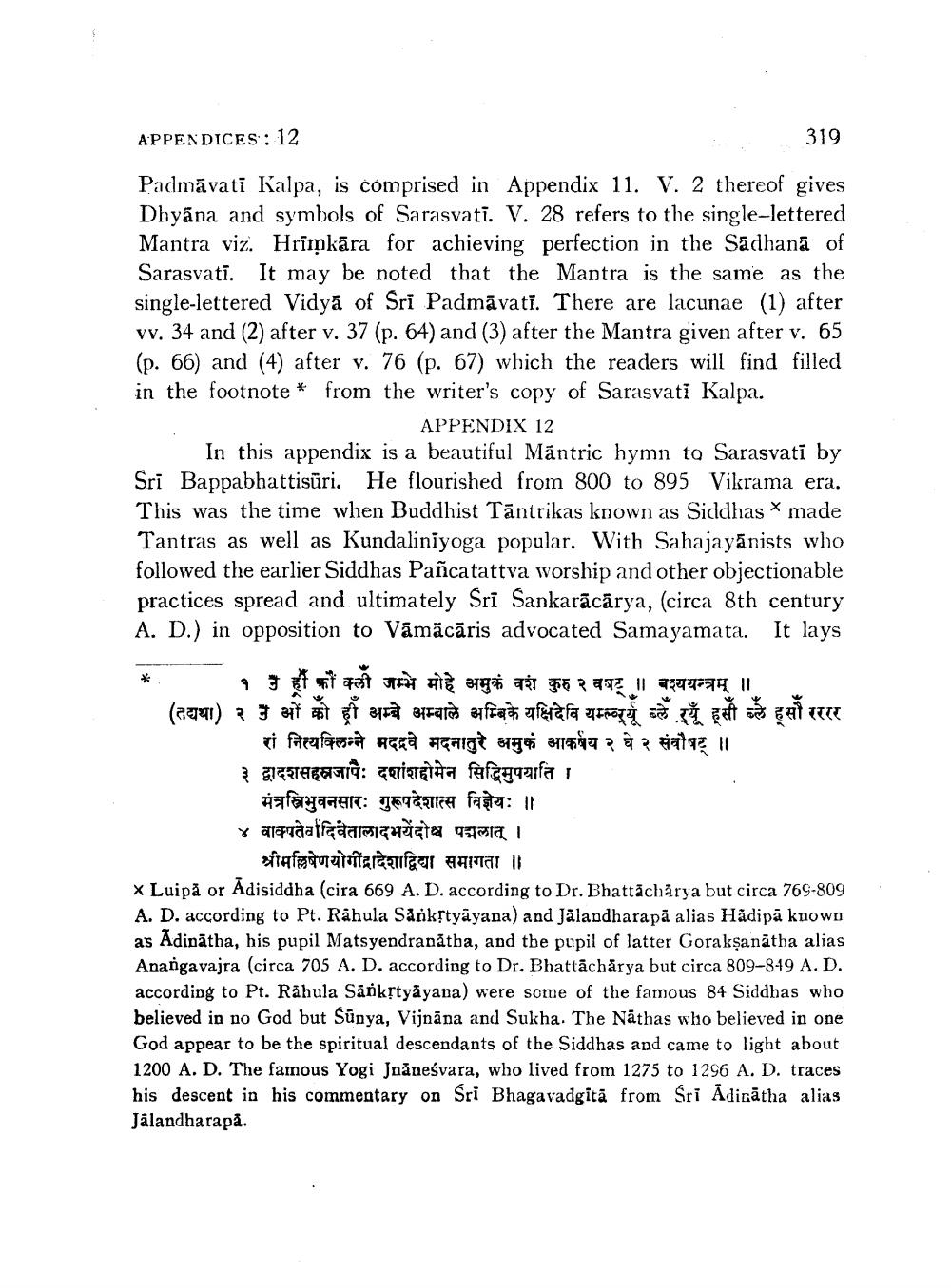________________
APPENDICES: 12
319
Padmavati Kalpa, is comprised in Appendix 11. V. 2 thereof gives Dhyana and symbols of Sarasvati. V. 28 refers to the single-lettered Mantra viz. Hrimkāra for achieving perfection in the Sadhana of Sarasvati. It may be noted that the Mantra is the same as the single-lettered Vidya of Sri Padmavati. There are lacunae (1) after vv. 34 and (2) after v. 37 (p. 64) and (3) after the Mantra given after v. 65 (p. 66) and (4) after v. 76 (p. 67) which the readers will find filled in the footnote* from the writer's copy of Sarasvati Kalpa.
APPENDIX 12
In this appendix is a beautiful Mantric hymn to Sarasvati by Sri Bappabhattisüri. He flourished from 800 to 895 Vikrama era. This was the time when Buddhist Tantrikas known as Siddhas made Tantras as well as Kundaliniyoga popular. With Sahajayānists who followed the earlier Siddhas Pañcatattva worship and other objectionable practices spread and ultimately Sri Sankarācārya, (circa 8th century A. D.) in opposition to Vāmācāris advocated Samayamata. It lays
१
हौं क्ली जम्भे मोहे अमुकं वशं कुरु २ वषट् ॥ वश्ययन्त्रम् ।। (तद्यथा) २ उओं को ड्राँ अम्बे अम्बाले अम्बिके यक्षिदेवि यम्यूँ ब्लें यूँ इसी ब्लै स रररर रां नित्यक्लिन्ने मददवे मदनातुरे अमुकं आकर्षय २ घे २ संवौषट् ||
३ द्वादशसहस्रजापैः दशांशहोमेन सिद्धिमुपयाति
मंत्र स्त्रिभुवनसारः गुरूपदेशात्स विज्ञेयः ॥
४ वाक्पतेव दिवेतालादभयेंदोश्च पद्मलात् ।
श्रीमल्लिषेण योगींद्रादेशाद्विद्या समागता ||
× Luipă or Adisiddha (cira 669 A. D. according to Dr. Bhattacharya but circa 769-809 A. D. according to Pt. Rahula Sankṛtyāyana) and Jalandharapa alias Hadipā known as Adinatha, his pupil Matsyendranatha, and the pupil of latter Gorakṣanatha alias Anangavajra (circa 705 A. D. according to Dr. Bhattacharya but circa 809-849 A. D. according to Pt. Rahula Sänkṛtyāyana) were some of the famous 84 Siddhas who believed in no God but Sunya, Vijnana and Sukha. The Nathas who believed in one God appear to be the spiritual descendants of the Siddhas and came to light about 1200 A. D. The famous Yogi Jnaneśvara, who lived from 1275 to 1296 A. D. traces his descent in his commentary on Sri Bhagavadgītā from Śrī Ādinātha alias Jalandharapå.




